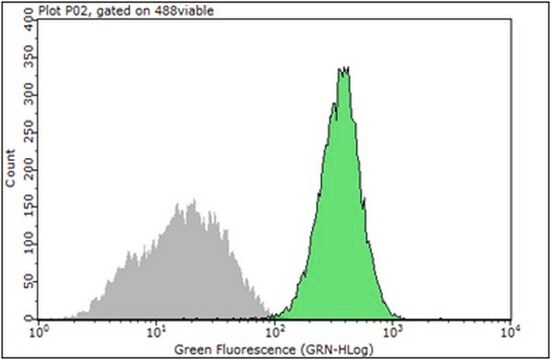AB1344
Anti-Glucose Transporter GLUT-3 Antibody, CT
serum, Chemicon®
Sign Into View Organizational & Contract Pricing
All Photos(2)
About This Item
UNSPSC Code:
12352203
eCl@ss:
32160702
NACRES:
NA.41
Recommended Products
biological source
rabbit
Quality Level
antibody form
serum
antibody product type
primary antibodies
clone
polyclonal
species reactivity
rat, mouse
manufacturer/tradename
Chemicon®
technique(s)
ELISA: suitable
western blot: suitable
NCBI accession no.
UniProt accession no.
shipped in
wet ice
target post-translational modification
unmodified
Gene Information
mouse ... Slc2A3(20527)
rat ... Slc2A3(25551)
Specificity
Recognizes Glut-3 in mouse and rat tissues. C terminal peptide used shows no homology to the human sequence.
Immunogen
Synthetic peptide corresponding to the C-terminus of mouse Glut-3 coupled to KLH. Product sold sold as AG617
Application
Anti-Glucose Transporter GLUT-3 Antibody, C-terminus is an antibody against Glucose Transporter GLUT-3 for use in ELISA & WB.
Western blotting: 1:1,000-1:5,000, using chemiluminescent detection. Detects a 45-48kDa band in membrane preps from rat brain. Slight differences in band sizes in different tissues; reported range is 45-55kDa.
Other detection methods may require a higher concentration of antibody.
ELISA: 1:10,000 - 1:50,000, using 50-100 ng of antigen/well.
Optimal working dilutions must be determined by end user.
Other detection methods may require a higher concentration of antibody.
ELISA: 1:10,000 - 1:50,000, using 50-100 ng of antigen/well.
Optimal working dilutions must be determined by end user.
Physical form
Liquid rabbit antiserum containing 0.05% sodium azide.
Storage and Stability
Store at -20°C for up to 12 months after date of receipt in undiluted aliquots. Avoid repeated freeze-thaw cycles.
Analysis Note
Control
The control peptide is available for absorbtion studies. Please see catalog number AG617.
The control peptide is available for absorbtion studies. Please see catalog number AG617.
Legal Information
CHEMICON is a registered trademark of Merck KGaA, Darmstadt, Germany
Not finding the right product?
Try our Product Selector Tool.
Storage Class Code
10 - Combustible liquids
WGK
WGK 1
Certificates of Analysis (COA)
Search for Certificates of Analysis (COA) by entering the products Lot/Batch Number. Lot and Batch Numbers can be found on a product’s label following the words ‘Lot’ or ‘Batch’.
Already Own This Product?
Find documentation for the products that you have recently purchased in the Document Library.
Sze Ting Cecilia Kwan et al.
The Journal of nutrition, 147(11), 2083-2092 (2017-09-22)
Background: Fetal growth is dependent on placental nutrient supply, which is influenced by placental perfusion and transporter abundance. Previous research indicates that adequate choline nutrition during pregnancy improves placental vascular development, supporting the hypothesis that choline may affect placental nutrient
C M Cheng et al.
Proceedings of the National Academy of Sciences of the United States of America, 97(18), 10236-10241 (2000-08-24)
The brain has enormous anabolic needs during early postnatal development. This study presents multiple lines of evidence showing that endogenous brain insulin-like growth factor 1 (Igf1) serves an essential, insulin-like role in promoting neuronal glucose utilization and growth during this
Cinzia Dello Russo et al.
The Journal of biological chemistry, 278(8), 5828-5836 (2002-12-18)
Activation of peroxisome proliferator-activated receptors (PPARs) can regulate brain physiology and provide protection in models of neurological disease; however, neither their exact targets nor mechanisms of action in brain are known. In many cells, PPAR gamma agonists increase glucose uptake
Raimund I Herzog et al.
The Journal of clinical investigation, 123(5), 1988-1998 (2013-04-02)
Hypoglycemia occurs frequently during intensive insulin therapy in patients with both type 1 and type 2 diabetes and remains the single most important obstacle in achieving tight glycemic control. Using a rodent model of hypoglycemia, we demonstrated that exposure to
Francesca Gaccioli et al.
Biology of reproduction, 89(4), 96-96 (2013-09-06)
The mammalian target of rapamycin (mTOR) and the eukaryotic initiation factor 2 (eIF2) signaling pathways control protein synthesis in response to nutrient availability. Moreover, mTOR is a positive regulator of placental nutrient transport and is involved in the regulation of
Our team of scientists has experience in all areas of research including Life Science, Material Science, Chemical Synthesis, Chromatography, Analytical and many others.
Contact Technical Service







